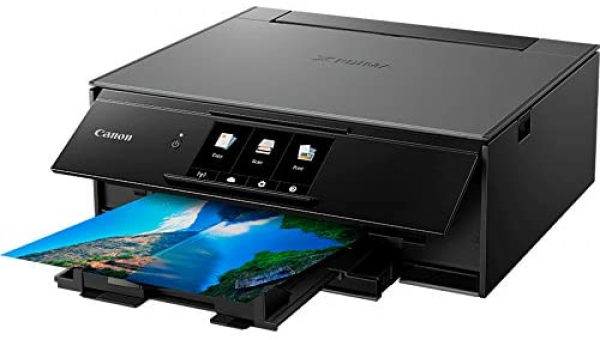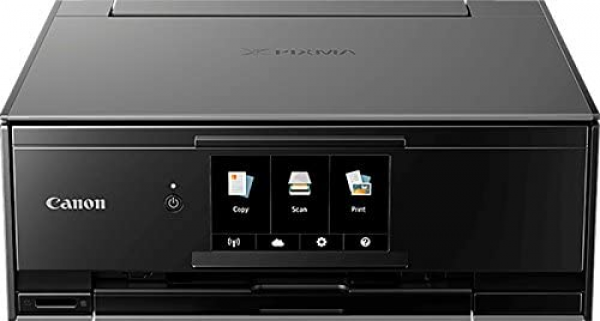Canon
Canon Pixma TS9150: the 3-in-1 inkjet printer that plays it premium
Aprox. 247€
See specificationsThe Pixma TS9150 represents the top of the basket when it comes to photo-oriented multifunction inkjet printers from Canon. And who says high-end says expensive: its recommended retail price is € 259. A very significant additional cost compared to the excellent TS8150 or TS8050, which are also loaded with functions and which can be found quite easily for around a hundred euros in trade . So, is the TS9150 worth its price? This is what we will see.
Positive points
Very compact format.
Full functionality.
Ease of use.
Quite sober to use.
Excellent rendering of impressions.
Bad points
Slow black and white printing.
Second paper source at the back less practical.
Frequent cleaning of the print heads.
Too expensive.
Our review
Ergonomics
Apart from the slightly more square lines, exclusive colors (dark gray and red), and the integration of a larger color touch screen (12.6, against 10.8 cm diagonally), nothing apparently differentiates this Pixma TS9150 from TS8050 and TS8150. This 3-in-1 printer also has the good taste to adopt the same measurements, therefore to be relatively compact (37.2 x 32.4 x 13.9 cm with all shutters closed). A mastered design whose merits we have already had the opportunity to praise, especially since it serves here a product with many possibilities.
Note the presence of an Ethernet port which is lacking in the TS8050 / TS8150. This is handy for those who would like to share this printer on a local network without using Wi-Fi, but obviously not enough to justify the significant price difference that separates it from these models. Like the other Pixma in this range, the TS9150 also manages Wi-Fi Direct and the main Cloud printing services.
Whether you use it from a computer, tablet or smartphone, it will always be there. Especially since the Canon Print app has improved over time and offers everything you would expect from a modern photo printing app. For example, you can easily connect to Facebook or Instagram account to retrieve photos, and the list of supported formats and papers is exhaustive, even including the 13 x 13 Polaroid version launched last year by Canon.
If like its little sisters, the Pixma TS9150 draws a line on the USB host port and presents on the front an SD card reader (the NFC module has however disappeared). Does enjoying an even bigger touchscreen make a real difference? No. Quite honestly, the TS8050 / TS8150 is already wide enough and legible to be perfectly pleasant to use. It is always a plus, but here too, the difference is not enough to justify such a price difference.
The main paper cassette, located at the front, can accommodate 100 plain sheets (80 g / m²). It is surmounted by the motorized drawer which receives the printed pages. A practical and once again quite compact system, which has the only flaw of asking a big ten seconds to unfold. Note that it is possible to leave it out when the printer is switched off to save time.
A second paper supply is located on the back of the printer. It compensates for the absence of a second cassette on the front, as it was previously found on high-end Pixma cameras. This new system seems less practical, but allows us to keep a second type of paper - photo for example - permanently available, provided that we can leave this folded out. This forces the printer to be detached from the wall by a good ten centimeters, while preventing it from being installed in a shelf space at the limited height.

Consumption
The power consumption of the Pixma TS9150 is in line with that of Canon printers in this range: 1 W in standby and 19 W in A4 photo printing. No good or bad surprise at this level, knowing that on this aspect, the Epson models of the Expression Home range are the ones that have impressed us the most recently (9 W in photo printing for the XP-445).
In terms of sound emission, no revolution either: the sound level meter measurements are close to those recorded on the TS8050 with 38.3 dB in photo and 39.4 dB in office automation. That remains, for once, a very good point: this Pixma TS9150 printer clearly ranks on the side of the quietest models that we have tested in recent times. Pixma MG, for example, was much more audible.
Cost per page
Here is one of the main differences from this TS9150: it works on the basis of 6 Canon 580/581 range cartridges, where the TS8050 used Canon 570/571. This is an opportunity for us to see what it can change, both in terms of cost per page and print rendering, knowing that the Pixma TS6150 and 8150 are also passed on this new set of cartridges.
Side cost per page, based on the largest official cartridges available (XXL format) and the lowest prices found online from reliable dealers, we arrive at a cost per page of € 0.032 (3.2 cents) euros) in black and white, and € 0.105 (10.5 cents) in color. This is slightly more than what we were able to calculate during our test of the TS8050 which, at € 0.097 (9.7 euro cents), managed to stay below the 10 cents in color bar.
The difference remains minimal and the TS9150 confirms that Canon multifunction inkjet printers are content to be average on this criterion, without making any more effort. In addition, these calculations do not take into account their tendency to sometimes abuse the cleaning cycles of the heads, with the consequence of wasting each time a little ink.
Scanner and copies
The TS9150's flatbed scanner can scan up to 4800 x 2400 dpi on 48 bits. It takes 12 seconds to scan a 10 x 15 cm photo in 300 pp and 8 s to do the same with a document in 100 dpi. It is, to the nearest second, the same results as with the TS8050 in photo and a second faster for the document. The quality of the scans is identical. Copies are also fast: 11 s for a black and white document, 13 s for a color document. As always in copy, we lose a bit of pep of the original documents, especially on the colors, but everything remains perfectly legible.
Photo
Printing up to 4800 x 1200 dpi with ChromaLife 100 inks, the Pixma TS9150 is, according to its technical sheet, capable of printing a 10 x 15 cm photo in around 17 s. It nevertheless takes 28 s to print our reference photo in this format, and 1 min 2 s to output an A4 photo. It's 12 seconds gained in 10 x 15 cm compared to the TS8050, and 7 seconds in A4. Again, slight improvements over Pixma from previous generations.
But as always in the photo, we ultimately attach much more importance to the quality of rendering than to the bit rates. Unsurprisingly, the rendering is excellent. However, if we stick to the analysis of color drift, the TS9150 is a little less faithful than the TS8050, and even than the Pixma MG7750. The average delta E measured here is 5.8, compared to 5 for the TS8050 and 5.3 for the MG7750 (the lower this number, the more faithful the colors measured).
However, the readings are relatively uniform, and the set remains among the best on the market. In terms of sharpness and overall rendering, the photos printed by this printer are flawless.
Office
In office automation, on this range, Canon retains its strengths and weaknesses. In terms of bit rates, the TS9150 is given for 10 pages per minute (ppm) in color and 15 ppm in black and white. We have found effective bit rates of 6.2 ppm black and white and 12.5 ppm color on our test documents. In both exercises, there was an increase compared to the TS8050, which had flow rates of 5.7 and 7.8 ppm respectively. Good color performance is therefore obtained, but in black and white, the printer is always penalized by the many pause times necessary for the ink to dry in order to avoid any overflow or transfer.
Finally, in office automation, the prints are of excellent quality: contrasting, crisp and precise, including the texts on white or colored backgrounds or the gradations and solid colors which are perfectly rendered.
Conclusion
The Canon Pixma TS9150 is an excellent multifunction inkjet printer which, if we stick strictly to its qualities of use, gleefully deserves its 5 stars. However, if we add the price component to this observation, it becomes difficult for it to justify a significant additional cost compared to the TS8050 or TS8150, which, with a few details, offer the same functions and performances, but are much more affordable.
Specifications

